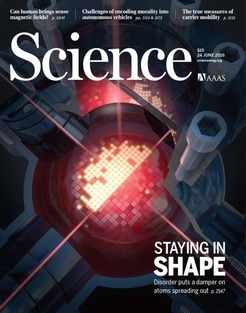July 06, 2016
During equilibration ordinary many-body systems lose all information about the initial state. Every morning we experience an example for this behaviour. Milk poured into a cup of coffee mixes perfectly and after some time it is impossible to say how exactly the two fluids were put together. The same behaviour holds for almost all quantum systems. However, recently a new phenomenon called “many-body localization” has been predicted theoretically, which allows well insulated quantum systems to preserve memory of the initial state forever. Now a team of scientists around Dr. Christian Groß and Professor Immanuel Bloch (Director at MPQ and Chair of Quantum Optics at LMU Munich), in cooperation with David Huse (Princeton University), has obtained evidence of such a behaviour in a two-dimensional quantum system of cold rubidium atoms trapped in an optical lattice (Science, 24 June 2016).
The scientists observed that – beyond a certain degree of disorder imprinted on the particle ensemble in the beginning – the system would relax into a steady state still containing detailed microscopic information about its past. “We were able to observe the transition from a thermalized state into a many-body localized phase”, Christian Groß points out. “It is the first observation of that kind in a regime that is not accessible with state-of-the-art simulations on classical computers.” The experiment is not only of fundamental interest; the results might also lead to new ways for storing quantum information.
Motivated by the foundational problem of how interacting particles behave in a disordered system, in the 1950s the American physicist Philip Warren Anderson discovered the famous localization phenomenon for non-interacting particles, now called “Anderson localization”. Here, disorder prevents the particles to move and consequently all transport is stopped. But what happens when disorder comes together with interactions? Will interactions lead to transport and thermalization, or will the localization persist even at high energies? So far, there is no theoretical model that faithfully predicts the evolution of a closed quantum system in more than one dimension under these conditions, although, the possibility for localization has been theoretically suggested.
In order to investigate these questions experimentally, strict requirements on controllability and perfect isolation of the system have to be fulfilled. In the experiment described here, ultracold rubidium atoms are loaded into an optical lattice, a microscopic array of light traps formed by interfering laser beams. The disorder is created by projecting a computer-generated random light pattern onto the optical lattice. As a result of this “disorder”, the depth of each microscopic trap in the lattice potential varies from site to site. In fact, Prof. Bloch’s group has advanced the experimental tools to such perfection that they can steer the position of the atoms in the artificial light crystal and the interaction between them almost at will. With a high resolution microscope that detects the emitted fluorescence light, the position of each atom can be observed with high precision. Additionally, the atomic density distribution of the initial state can be controlled, and for variable time intervals the evolution of the distribution can be measured with high precision.
These tools at hand, non-thermalizing behaviour can be probed in a conceptionally very simple way. Any thermalized state of a closed system reflects the symmetry of its container – like, for example, water spilled into a round bowl would immediately cover the whole bottom. In analogy, the scientists generate a density step in the initially prepared sample by blowing away half of the atomic distribution with laser radiation. Then they watch how the remaining particles migrate into the empty half. For small disorders, the initially prepared density step is smeared out fast and the initially empty and filled halves become indistinguishable. However, when the measurement is repeated for strong disorder, traces of the initial state remain and the system does not relax to a thermal state even for very long times. “We observe a fairly sharp onset of non-thermalizing behaviour above a critical value”, says Christian Groß. “This absence of thermalization is remarkable because it persists in a system of interacting particles, even at the high energies probed in the experiment.”
The scientists interpret their observation as the onset of many-body localization in the atomic system. This is of fundamental interest because it means the breakdown of equilibrium statistical mechanics. On the other hand, the persistence of initial state information could be used as a source for quantum information technologies. “It should also be emphasized that we obtain these results for a system size that is far beyond numerically accessible scales”, says Jae-yoon Choi, postdoc at the experiment.
Olivia Meyer-Streng
original publication
Jae-yoon Choi, Sebastian Hild, Johannes Zeiher, Peter Schauß, Antonio Rubio-Abadal, Tarik Yefsah, Vedika Khemani, David A. Huse, Immanuel Bloch, and Christian Groß
Exploring the many-body localization transition in two dimensions
Science, 24 June 2016, DOI: 10.1126/science.aaf8834















